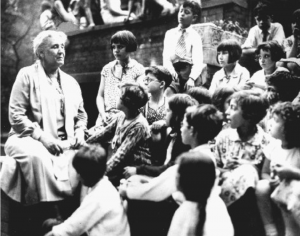
Jane Addams’ Hull House was an influential immigration settlement during the Progressive Era that served not only as a safe haven for immigrants but as an educational hub in the areas of work skills, health and safety as well as music. Music education, one of the most unique elements of Hull House learning programs, educated immigrants about their own conditions, and also created awareness among the surrounding community of the struggles of immigrants in American society. Eleanor Smith’s Hull House Songs is but one product of the music education curriculum at Hull House that reflects the immigrants’ struggles in areas such as suffrage, sweatshop conditions, and mining hazards. As a commemorative publication for the 25th anniversary of the settlement, Smith’s Hull House Songs provides unique insight into the plight of the American immigrant and the educational system that Hull House provided for these workers.
Jane Addams and Eleanor Smith: A Quick Bio
The importance of music in the Hull House of Chicago is under appreciated and often overlooked. While its purpose of acculturating immigrant Americans was highly significant, the innovative artistic programs were vastly influential among these outsiders. Jane Addams was not only recognized for her achievements in Hull House, she was actively involved in American philanthropic efforts and advancements for women and immigrants. Jane Addams was persuasive within the Hull House and, in response, Hull house advocated for common day social welfare
programs such as the American Civil Liberties Union and NAACP. Eleanor Smith added to the cultural development of the settlement by founding its music program in 1893. Not only did Smith’s music program influence musical taste, it was often reflective of the political movements and problems that existed in the United States. It therefore was a form of political activism and educated residents about political issues and human rights through the fundamental tools of music. While primarily focused on creating change within, Smith’s musical actions flowed beyond the walls of Hull House and spilled over into the lives of community members. Both women were extremely important to the development of immigrant life and their process of assimilation. The use of music quickened the process and in doing so, was politically compelling.
The Source: Hull House Songs
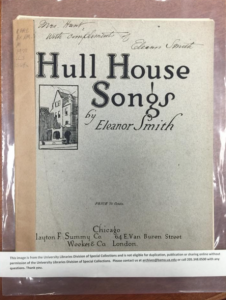
Source: Smith, Eleanor. Hull House Songs. Chicago: Clayon F. Summy, 1915. Print. Held in the W.S. Hoole Special Collections Library.
The music collection Hull House Songs held at Hoole Special Collections Library at The University of Alabama was published in 1915 to commemorate the 25th anniversary of The Hull House. The document has a simple tape binding that was most likely chosen for its efficiency. The cover of Hull House Songs presents the title in large plain lettering with slightly decorated capitals as well as a small illustration of The Hull House itself. The cover of this particular score includes a personal written note from the composer reading “Mrs. Hart, With Compliments, Eleanor Smith”. The identity of Mrs. Hart is unknown, but the dedication provides a unique personalization indicating Eleanor Smith’s hands-on involvement in the distribution of the publication.
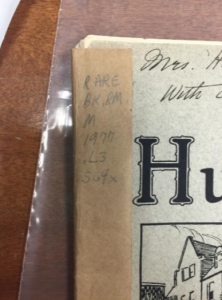
Source: Smith, Eleanor. Hull House Songs. Chicago:
Clayon F. Summy, 1915. Print. Held in the W.S. Hoole Special Collections Library.
The next two pages include a cover page that essentially reproduces the cover as well as a note from Jane Addams about the purpose of the compositions. The musical score includes five songs: “The Sweat Shop”, “The Shadow Child”, “The Land of the Noonday Night”, “Suffrage Song”, and “Prayer”. The starting page of each song has a title at the top and the musical score below. Each score also includes a vocal line, which indicates that these pieces were meant to be sung, most likely as a group or choir or solo voice.
The sole accompaniment of these songs is piano, a common household instrument in the early twentieth century. The pages of the book are a faded cream color and are printed on sturdy, heavy paper. Surprisingly, there are no visible tears or holes in any pages of the musical score. Despite the user-friendly format of this publication, this particular copy is in surprisingly good condition, most likely due to the personalized dedication on the cover.
The Purpose of the Publication
Although there is not a great deal of secondary information available regarding Hull House Songs directly, this publication offers clues to its own intention and purpose. Addams and Smith had great motivations to be honest in the publication of these songs. By choosing to be as honest as possible, Addams and Smith formed a political tool to gain sympathy from the general populace and presented a cause for the audience to get behind. The politically charged nature of the included songs indicates an intention to both inform and persuade the audience. The book as a whole addresses a number of social reform topics which help to inform the singer or reader of the various plights being faced by the typical resident of Hull House. At the same time, these songs attempt to persuade the audience to sympathize and take action to relieve the persisting struggles of these immigrants and members of the working class. In the foreword to the book, Addams states her belief that “socialized emotions should also find musical expression” in society. Clues such as these offer direct evidence that Hull House Songs was intended to make a significant impact in the public sphere of the Progressive Era.
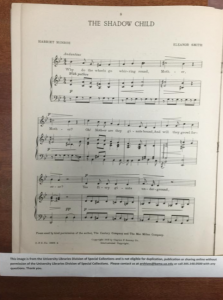
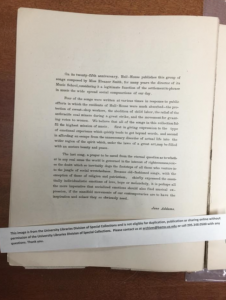
Source: Smith, Eleanor. Hull House Songs. Chicago: Clayon F. Summy, 1915. Print.
Music Education at Hull House
Music was an essential element of the education programs offered to Hull House residents. The Hull House Music School opened its doors in 1893. Musical instruction was used as a device for assimilating immigrants into American culture because it “embodies object lessons of self- and group cultivation that [seem] well-tailored to the project of domesticating and uplifting” (Vaillant 98). Eleanor Smith, the head of the music school, taught countless immigrant students the basics of vocal and instrumental music.
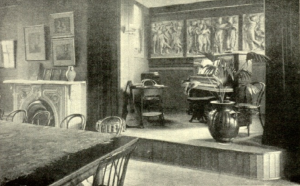
Smith personally composed much of what she taught her students and “endeavored to connect the musical experiences of pupils in every way possible with the racial background of the family” (Vaillant 110). Smith had a unique ability of assimilating her students into American life while still embracing the roots of their heritage. Hull House became increasingly known for its weekly Sunday concerts put on by its residents. As time passed, the audiences of these concerts continued to grow. The format of these performances included “solo vocal and piano pieces interspersed with group numbers by various singing classes” (Elrod 59). As the audiences grew, Hull House had increasing opportunities to reach further into the community and make its audiences more aware of the work of the settlement house and the experiences of its residents.
Conclusion
The outreach and resources that music within Hull House provided immigrants in Chicago reached beyond the arts and shaped politics during the late nineteenth and early twentieth centuries. The music produced in Hull House conveyed the everyday struggles of immigrants, laborers, those in poor working conditions, and women. The stand taken by members of Hull House relays a message that these problems not only existed among American citizens, but among all inhabitants of the United States. While Hull House expanded to become a place of solace and comfort for the community, its unchanging goal of positively impacting the community never waned.
Bibliography
Addams, Jane. Photograph. Britannica Online for Kids. Web. 4
Elrod, Pamela Gail. “Vocal Music at Hull-House, 1889–1942: An Overview of Choral and Singing Class Events and a Study of the Life and Works of Eleanor Smith, Founder of the Hull-House Music School.” Order No. 3023050 University of Illinois at Urbana- Champaign, 2001. Ann Arbor: ProQuest. Web. 4 Oct. 2015.
Green, Shannon Louise. “”Art for Life’s Sake”: Music Schools and Activities in United States Social Settlements, 1892–1942.” Order No. 9826426 The University of Wisconsin – Madison, 1998. Ann Arbor: ProQuest. Web. 4 Oct. 2015.
Hull House Interior. Outline Sketch Descriptive of Hull House. Pfeiffer University, n.d. Web. 4 Oct. 2015.
Smith, Eleanor. Hull House Songs. Chicago: Clayon F. Summy, 1915. Print.
Vaillant, Derek. Sounds of Reform: Progressivism & Music in Chicago, 1873-1935. Chapel Hill: U of North Carolina P, 2003. Print.
Jordan Mlcoch, Diana Boone, Laurel Wenckowski